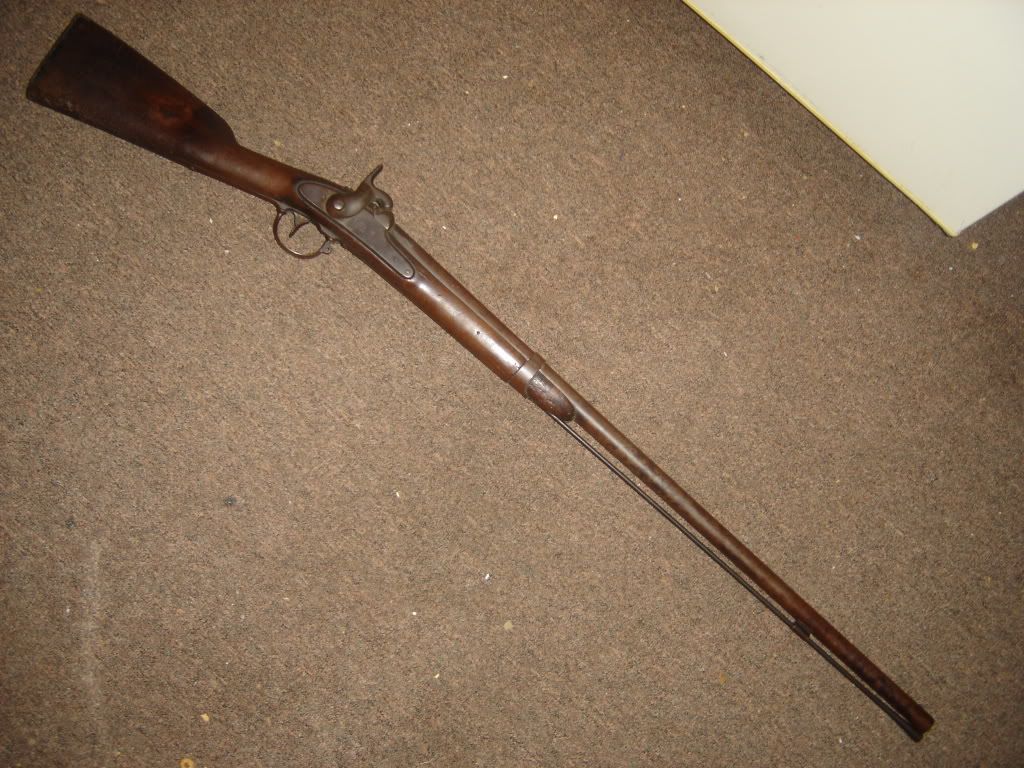DutchmanDick
40 Cal.
- Joined
- Mar 30, 2009
- Messages
- 192
- Reaction score
- 0
I found what I think is an interesting gun in a local gun shop that has been around for many, many years (the oldster who owns the shop says he's got guns that have been in storage in the basement of the shop for 50 years or more, and he rotates them out onto the sales floor every so often).
The gun is a Springfield M1842 musket, with a lockplate dated 1845, that was converted into a civilian shotgun. The stock was cut back, a ramrod thimble brazed to the underside of the barrel (the original iron ramrod was retained), the original front barrel band modified to retain the barrel at the new forearm end, and a bead put on the muzzle. It still retains the original buttplate and trigger guard (sans sling swivel). It looks like the conversion was done long ago, and I've seen similar guns in my reprints of the fall/winter 1894-1895 Monkey Wards catalogue and my 1927 Bannerman's catalogue. I'm guessing they were available even earlier than that - perhaps even before the Civil War, since although 1842's were used in that war they were essentially obsolete once the 1855 rifle-musket came into general use, and this gun would already have been 16 years old when the war started.
Overall condition is pretty decent. It has obviously been used, but not abused. There is a brown patina, and the stock is dark and has a somewhat rough texture, but no pitting that I could see and no chunks of wood missing. Even the bore - or what I could see of it - was still smooth, albeit again with a brown patina inside.
Needless to say, I couldn't resist putting the gun on layaway. Given its overall condition, I think $500 was a reasonable asking price, and it should make an interesting shooter (once I check the rest of the bore for condition, that is...). I may even, one day, restore it to original military configuration, since exact repro parts are available.
The gun is a Springfield M1842 musket, with a lockplate dated 1845, that was converted into a civilian shotgun. The stock was cut back, a ramrod thimble brazed to the underside of the barrel (the original iron ramrod was retained), the original front barrel band modified to retain the barrel at the new forearm end, and a bead put on the muzzle. It still retains the original buttplate and trigger guard (sans sling swivel). It looks like the conversion was done long ago, and I've seen similar guns in my reprints of the fall/winter 1894-1895 Monkey Wards catalogue and my 1927 Bannerman's catalogue. I'm guessing they were available even earlier than that - perhaps even before the Civil War, since although 1842's were used in that war they were essentially obsolete once the 1855 rifle-musket came into general use, and this gun would already have been 16 years old when the war started.
Overall condition is pretty decent. It has obviously been used, but not abused. There is a brown patina, and the stock is dark and has a somewhat rough texture, but no pitting that I could see and no chunks of wood missing. Even the bore - or what I could see of it - was still smooth, albeit again with a brown patina inside.
Needless to say, I couldn't resist putting the gun on layaway. Given its overall condition, I think $500 was a reasonable asking price, and it should make an interesting shooter (once I check the rest of the bore for condition, that is...). I may even, one day, restore it to original military configuration, since exact repro parts are available.





